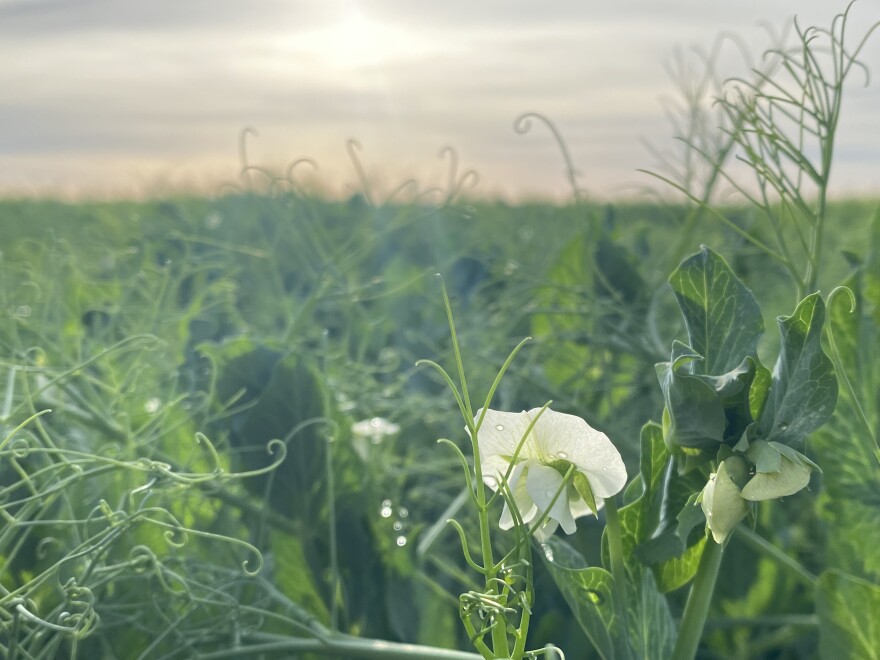On a warm day in Centralia, Washington, south of Olympia, Alan Woods is standing surrounded by his 90 million bees.
“So, we’re in the middle of the bee field,” he said. “You look around, and you can see bees everywhere.”
A halo of bees buzzes around his head; he’s not wearing a protective veil.
Woods, who heads the Washington State Beekeepers Association, is what’s called a sideliner beekeeper, or a small operator. It can be a tough business. Woods said beekeepers lose about 30 percent of their hives per year now, and he often comforts beekeepers who’ve lost hives. He’s also a Christian pastor, maybe even a bee-pastor.
“I talk to a lot of people about God and bees at the same time,” Woods said with a chuckle.

Commercial beekeepers around the United States rent more than 2 million hives to pollinate almond crops in California. Hundreds of thousands of those hives are trucked from the greater Northwest.
However, there’s a problem this year. The pandemic, international shipping problems and over-planting have led to a glut of nuts in California, and almond growers there are in bad economic shape. Many of them are reducing their top expenses – like bees. That’s an issue for the beekeepers of the Northwest who rely on the income – and for the bees themselves.
Brandon Hopkins, a Washington State University honeybee researcher, keeps a close eye on the industry.

Hopkins said that after winter, bees wake up weak with diminished numbers in each colony. Pollinating almonds nourishes them with an abundant flow of nectar and pollen. He said the bees that are sent to California return home stronger and often double their colony numbers, splitting into new colonies.
Hopkins said this year, fewer colonies went to California. Some almond orchardists couldn’t afford the insects; others tried to scrape by with fewer bees than normal.
“If a half million colonies don’t go to almonds, then you have a half million colonies that sort of miss that really early spring buildup,” Hopkins said. “And so you have … fewer colonies from which you can do those early spring splits and things like that.”

He said those half million colonies mean, ultimately, a million colonies missing in the commercial bee ecosystem – that's a $100 million hit to the beekeeping industry, and that’s not good news for fruit growers in the Northwest.
“I think what’s not so well known is how much the almond industry has really supported all the other industries that depend on honeybees for pollination,” Hopkins said. That
includes Washington and Oregon apples, cherries and vegetable crops.

Meanwhile, commercial beekeepers have to keep an eye on their economic health. This year, Bud Wilhelm, who runs a large commercial beekeeping operation in Royal City, Washington, didn’t bring all of his 8,000 colonies to California, the way he usually would. It’s expensive and a big risk — shipping costs, feed for the bees, hotels for his workers.
“It was wise on our part to hold back some hives,” Wilhelm said. He wasn’t sure that he would get paid. “Especially, as some of these individuals I thought would pay, who are in a strong cash position, and who know me personally, you know, they are struggling to find the money to get us paid for those services.”
Wilhelm said bees are a sensor of things across the wider agricultural ecosystem. Many in ag are struggling now, he said. For the first time in his 15 years of beekeeping business, Wilhelm is seeing growers needing payment plans to cover his pollination services. He said farmers are tough.
“Even through all that strength and that hope and faith that these farmers have, they get to a point where they just financially can’t do it,” he said.
Wilhelm said for almonds and bees, he hopes for a brighter day.

Produced with assistance from the Public Media Journalists Association Editor Corps funded by the Corporation for Public Broadcasting, a private corporation funded by the American people.


